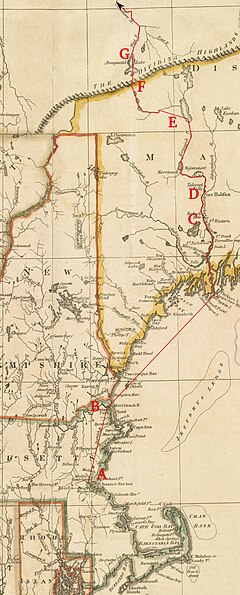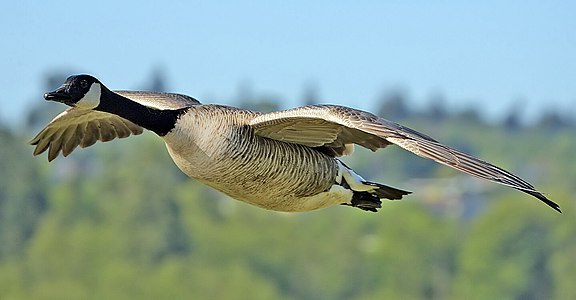| Showcase | Content | Contributing |
Introduction
Canada is a country in North America. Its ten provinces and three territories extend from the Atlantic Ocean to the Pacific Ocean and northward into the Arctic Ocean, making it the world's second-largest country by total area, with the world's longest coastline. Its border with the United States is the world's longest international land border. The country is characterized by a wide range of both meteorologic and geological regions. It is a sparsely inhabited country of 40 million people, the vast majority residing south of the 55th parallel in urban areas. Canada's capital is Ottawa and its three largest metropolitan areas are Toronto, Montreal, and Vancouver.
Canada is a parliamentary democracy and a constitutional monarchy in the Westminster tradition. The country's head of government is the prime minister, who holds office by virtue of their ability to command the confidence of the elected House of Commons and is "called upon" by the governor general, representing the monarch of Canada, the ceremonial head of state. The country is a Commonwealth realm and is officially bilingual (English and French) in the federal jurisdiction. It is very highly ranked in international measurements of government transparency, quality of life, economic competitiveness, innovation, education and gender equality. It is one of the world's most ethnically diverse and multicultural nations, the product of large-scale immigration. Canada's long and complex relationship with the United States has had a significant impact on its history, economy, and culture.
A developed country, Canada has a high nominal per capita income globally and its advanced economy ranks among the largest in the world, relying chiefly upon its abundant natural resources and well-developed international trade networks. Recognized as a middle power, Canada's strong support for multilateralism and internationalism has been closely related to its foreign relations policies of peacekeeping and aid for developing countries. Canada is part of multiple international organizations and forums. (Full article...)
Featured article -

*A: Cambridge
*B: Newburyport
*C: Fort Western
*D: Fort Halifax
*E: Great Carrying Place
*F: Height of land
*G: Lake Mégantic
This map does not accurately represent the area around the height of land and Lake Mégantic.
In September 1775, early in the American Revolutionary War, Colonel Benedict Arnold led a force of 1,100 Continental Army troops on an expedition from Cambridge in the Province of Massachusetts Bay to the gates of Quebec City. The expedition was part of a two-pronged invasion of the British Province of Quebec, and passed through the wilderness of what is now Maine. The other expedition invaded Quebec from Lake Champlain, led by Richard Montgomery. (Full article...)
Featured biography -
Peter Charles Archibald Ewart Jennings CM (July 29, 1938 – August 7, 2005) was a Canadian-American television journalist, best known for serving as the sole anchor of ABC World News Tonight from 1983 until his death from lung cancer in 2005. Despite dropping out of high school, Jennings transformed himself into one of American television's most prominent journalists. (Full article...)
Selected panorama -
National symbol -
Parliament Hill (French: Colline du Parlement), colloquially known as The Hill, is an area of Crown land on the southern bank of the Ottawa River that houses the Parliament of Canada in downtown Ottawa, Ontario, Canada. It accommodates a suite of Gothic revival buildings whose architectural elements were chosen to evoke the history of parliamentary democracy. Parliament Hill attracts approximately three million visitors each year. The Parliamentary Protective Service is responsible for law enforcement on Parliament Hill and in the parliamentary precinct, while the National Capital Commission is responsible for maintaining the nine-hectare (22-acre) area of the grounds. (Full article...)
Selected vital article -
Canadian cuisine consists of the cooking traditions and practices of Canada, with regional variances around the country. First Nations and Inuit have practiced their culinary traditions in what is now Canada for at least 15,000 years. The advent of European explorers and settlers, first on the east coast and then throughout the wider territories of New France, British North America and Canada, saw the melding of foreign recipes, cooking techniques, and ingredients with indigenous flora and fauna. Modern Canadian cuisine has maintained this dedication to local ingredients and terroir, as exemplified in the naming of specific ingredients based on their locale, such as Malpeque oysters or Alberta beef. Accordingly, Canadian cuisine privileges the quality of ingredients and regionality, and may be broadly defined as a national tradition of "creole" culinary practices, based on the complex multicultural and geographically diverse nature of both historical and contemporary Canadian society. (Full article...)
Selected picture -
Credit: Image by Alan D. Wilson, modified by Diliff (cropped and noise reduction applied).
Current events
- June 19, 2024 – Canada–Iran relations
- Canada adds Iran's Islamic Revolutionary Guard Corps to its list of terrorist entities. (Bloomberg)
- June 12, 2024 –
- The Royal Canadian Geographical Society announces that a Canadian-led team has located the wreckage of Quest, the polar exploration ship of the Shackleton–Rowett Expedition off the coast of Labrador, Newfoundland and Labrador, Canada. (Reuters)
- May 31, 2024 –
- Canadian serial killer Robert Pickton dies in prison after being attacked by another inmate earlier this month. (AP)
- May 21, 2024 –
- Canadian serial killer Robert Pickton is reported to be on life support after being physically attacked in a prison in Port-Cartier, Quebec. (Vancouver Sun)
- May 18, 2024 –
- Three people are killed and five others are injured in a boat collision on Bobs Lake in Ontario, Canada. (CBC News)
- May 17, 2024 –
- A child in Hamilton, Ontario, Canada, dies of measles, the province's first such death since 1989. (CBC News)
Did you know -

- ... that the Allenby Formation has been called part of a "Great Canadian Lagerstätte"?
- ... that after Norman Dawe died, he was described as "a victim of [ice] hockey because he worked too hard for it"?
- ... that the parasitic fossil fungus Paleoserenomyces allenbyensis was named after a Canadian ghost town?
- ... that the now-destroyed statue of Alexander Wood was the first LGBT monument in Canada?
- ... that during combat, the Canadian-designed SW1C radar failed to find not only its U-boat target, but also an iceberg near the ship?
- ... that over his long career in aviation, Andy Carswell was shot down over Germany, made two famous rescues, met Queen Elizabeth II, and upset the Canadian transport safety establishment?
- ... that the Aubinadong River in Ontario, Canada, was an indigenous canoe route and is still used for canoe camping as its main recreational activity?
Featured list -
The 400-series highways are a network of controlled-access highways in the Canadian province of Ontario, forming a special subset of the provincial highway system. They are analogous to the Interstate Highway System in the United States or the Autoroute system of neighbouring Quebec, and are regulated by the Ministry of Transportation of Ontario (MTO). The 400-series designations were introduced in 1952, although Ontario had been constructing divided highways for two decades prior. Initially, only Highways 400, 401 and 402 were numbered; other designations followed in the subsequent decades. The network is situated almost entirely in Southern Ontario, although Highway 400 extends into the more remote northern portion of the province. (Full article...)
Main articles
Associated Wikimedia
The following Wikimedia Foundation sister projects provide more on this subject:
-
 Commons
Commons
Free media repository -
 Wikibooks
Wikibooks
Free textbooks and manuals -
 Wikidata
Wikidata
Free knowledge base -
 Wikinews
Wikinews
Free-content news -
 Wikiquote
Wikiquote
Collection of quotations -
 Wikisource
Wikisource
Free-content library -
 Wikiversity
Wikiversity
Free learning tools -
 Wikivoyage
Wikivoyage
Free travel guide -
 Wiktionary
Wiktionary
Dictionary and thesaurus
























Recent Comments